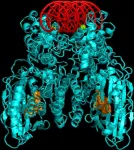(Press-News.org) Daily exposure to chemicals used in the manufacture of plastic food containers and many cosmetics may be tied to nearly 56,600 preterm births in the U.S. in 2018, a new study shows. The resulting medical costs, the authors of the report say, were estimated to reach a minimum of $1.6 billion and as much as $8.1 billion over the lifetime of the children.
For decades, the chemicals, called phthalates, have been shown to interfere with the function of certain hormones, or signaling compounds that circulate in the blood and guide much of the body’s processes. Exposure to these toxins, which is believed to occur as consumer products break down and are ingested, has been linked to obesity, cancer, and fertility issues, among many other health concerns.
Led by researchers at NYU Grossman School of Medicine, the new analysis of phthalate exposure in more than 5,000 American mothers has specifically linked it to increased risk of lower weight and gestational age (the period of time between conception and birth) among newborns. These risk factors, the authors say, are known to at least modestly heighten risk for infant death, interfere with academic performance, and may potentially contribute to heart disease and diabetes. According to their results, roughly 10% of all preterm births that occurred in 2018 could be linked to the chemicals.
“Our findings uncover the tremendous medical and financial burden of preterm births we believe are connected to phthalates, adding to the vast body of evidence that these chemicals present a serious danger to human health,” said study lead author Leonardo Trasande, MD, MPP. “There is a clear opportunity here to lessen these risks by either using safer plastic materials or by reducing the use of plastic altogether whenever possible,” added Trasande, the Jim G. Hendrick, MD, Professor in the Department of Pediatrics at NYU Langone Health.
The study, publishing online Feb. 6 in the journal The Lancet Planetary Health, is believed to be the largest of its kind to date and includes information from a much more racially and ethnically diverse group of women than previous studies on the topic, says Trasande.
For the research, the team analyzed data from the Environmental Influences on Childhood Health Outcomes (ECHO) program, an initiative by the National Institutes of Health to better understand the effects of a wide range of environmental, social, and economic factors on children’s health. The information, which ranged from access to food and the impact of racism and income inequality to toxin exposures, allowed researchers to account for and separate out demographic factors besides phthalates that could influence preterm birth, says Trasande.
To assess prenatal phthalate exposure, the researchers measured levels of 20 different metabolites (the components into which the chemicals break down within the body) in urine samples collected at three points during each subject’s pregnancy. Then, the team looked for associations between these metabolite levels and preterm births. Next, they estimated the resulting monetary costs from intensive-care-unit stays and other related medical bills, and lost worker productivity over a lifetime from lowered IQ points.
Besides examining overall exposure to the toxins, the authors also searched for distinctions between specific phthalates. In particular, they compared di-2-ethylhexyl phthalate (DEHP), a chemical long used to make plastic more flexible, with several newer replacements for DEHP, which has faced heightened scrutiny in recent years.
According to the findings, when grouping mothers based on the amount of DEHP metabolites in their urine, the 10% with the highest levels had a 50% increased risk of giving birth before week 37 of their pregnancy compared with the 10% with the lowest levels. Meanwhile, the risk for preterm birth was doubled for women exposed to the highest quantities of three common DEHP alternatives, di-isodecyl phthalate (DIDP), di-n-octyl phthalate (DnOP), and diisononyl phthalate (DiNP), compared with those who had little to no exposure.
“These results demonstrate the need to regulate phthalates as a class rather than trying to address them one at a time,” said Trasande, a professor in the Department of Population Health at NYU Langone. “Otherwise, investigators are likely going to find the same study results in another few years about the next group of chemicals used as replacements.”
According to Trasande, who is also the director of NYU Langone’s Division of Environmental Pediatrics, the authors next plan to expand their analysis to exposures in other countries and to examine the health effects of preventing phthalate exposure in the first place. California, among a few states, has banned some use of phthalates in consumer products, as have European Union member states.
Trasande cautions that further research is needed to better understand the specific mechanisms behind the link between phthalate exposure and preterm birth.
Funding for the study was provided by National Institutes of Health grants P2CES033423, U2COD023375, U24OD023382, U24OD023319, UH3OD023285, UH3OD023305, UH3OD023251, UH3OD023248, UH3OD023318, UH3OD023271, UH3OD023342, UH3OD023272, and UH3OD023290.
In addition to Trasande, another NYU investigator involved in the study is Mrudula Naidu, MPH. Other study authors include Morgan Nelson, MS, at RTI International in Research Triangle Park, N.C.; Akram Alshawabkeh, PhD, at Northeastern University in Boston; Emily Barrett, PhD, at Rutgers University in Piscataway, N.J.; Jessie Buckley, PhD, and Anne Starling, PhD, at Johns Hopkins University in Baltimore, Md.; and Dana Dabelea, MD, at the University of Colorado in Aurora. Study co-investigators include Anne Dunlop, MD, at Emory University in Atlanta, Ga.; Julie Herbstman, PhD, at Columbia University in New York; John Meeker, ScD, at the University of Michigan in Ann Arbor; Craig Newschaffer, PhD, at Pennsylvania State University in Hershey; Amy Padula, PhD, at the University of California, San Francisco; Megan Romano, PhD, at Dartmouth College in Lebanon, N.H.; Douglas Ruden, PhD, at Wayne State University in Detroit; Sheela Sathyanarayana, MD, at the University of Washington in Seattle; Susan Schantz, PhD, at the University of Illinois in Urbana. Ghassan Hamra, PhD, at Johns Hopkins University, served as study senior author.
Media Inquiries:
Shira Polan
Phone: 212-404-4279
shira.polan@nyulangone.org
END
Preterm births linked to ‘hormone disruptor’ chemicals may cost united states billions
2024-02-07
ELSE PRESS RELEASES FROM THIS DATE:
We must tackle female ageism in sport and exercise science, urge researchers
2024-02-07
Action is urgently needed to address the dearth of older women in sport and exercise science, not only for the sake of the growing numbers of female athletes, but women’s health in general, urge a group of international researchers in an editorial, published online in the British Journal of Sports Medicine.
There are already far too few sports and exercise science studies that include women, point out the authors, citing their own 2021 report on the sex data gap.
This showed that out of 5261 studies, from across six popular sport and exercise science journals, women and girls made up just over a third of the total number of participants, a figure that is likely ...
Women may find it harder to adjust to later life divorce and break-ups than men
2024-02-07
Women may find it harder to emotionally adjust to divorce or a relationship break-up in later life than men do, if patterns of antidepressant use are indicative, suggests a large long term study published online in the Journal of Epidemiology & Community Health.
While both sexes increased their antidepressant use in the run up to, and immediate aftermath of, a divorce, break-up, or bereavement, women’s use of these drugs was greater than men’s. And while re-partnering was associated with a slight reduction in antidepressant use in both sexes, it was particularly short-lived in women, the study findings indicate.
Due to population ...
High weekly physical activity levels linked to lower kidney disease risk in diabetes + overweight/obesity
2024-02-07
Clocking up high weekly levels of moderate to vigorous intensity physical activity is linked to a lower risk of developing chronic kidney disease in overweight/obese people with type 2 diabetes, finds research published online in the British Journal of Sports Medicine.
But boosting the weekly tally by just over an hour is linked to a 33% reduction in risk, with the effects apparent for bouts lasting above or below 10 minutes at a time, the findings indicate.
Diabetes is the leading cause of chronic kidney disease, accounting for 30–50% of all such cases. Diabetes plus chronic kidney disease is associated with a 10-fold or greater increase in the risk of death from any cause ...
Monterey Bay Aquarium study reveals how kelp forests persisted through the large 2014-2016 Pacific marine heatwave
2024-02-07
New research led by Monterey Bay Aquarium and the University of California, Santa Cruz, reveals that denser, and more sheltered, kelp forests can withstand serious stressors amid warming ocean temperatures. Published in Proceedings of the Royal Society B, the study also offers the first comprehensive assessment of how declines in kelp abundance affected marine algae, invertebrates, and fishes living in Monterey Bay. The study comes after a multi-year marine heatwave – the product of a 2014 ‘blob’ ...
Early drawing and building skills linked to enhanced education and behaviour in children
2024-02-07
Fine motor skills in young children are linked to better GCSE scores and fewer behavioural problems in childhood and adolescence, according to a new study from the University of Surrey and Birkbeck, University of London. The authors suggest that preschool fine motor skills, including drawing, folding paper and block building, may play an important role in the pathway between infancy and later educational and behavioural outcomes in primary and secondary school.
The study showed that fine motor skills ...
NLR researcher named Fellow of Society of Photo-Optical Instrumentation Engineers (SPIE)
2024-02-07
WASHINGTON – U.S. Naval Research Laboratory research physicist Lynda E. Busse, Ph.D., was named a Fellow of SPIE, the international society for optics and photonics, for outstanding technical contributions to the development of novel infrared (IR) optical materials and photonics devices.
Announced December 2023, the 47 new Fellows represent high-profile leaders in academia, industry, and government, and are being honored for their technical achievements as well as for their service to SPIE and the optics and photonics community. Dr. Busse was recognized along with many of the other new Fellows at the 2024 SPIE Photonics West Conference in San Francisco, California ...
A Filipino fruit dove, long part of Peabody collection, reveals its secrets
2024-02-06
In May 1953, Filipino ornithologist D. S. Rabor collected a single female fruit dove on the forested slopes of an active volcano on the Philippine island of Negros. The small apple green bird, which had yellow edgings on its wings and prominent circles of bare skin around its eyes, was unlike any other known pigeon species. In 1954, Rabor and Yale professor Dillon Ripley described the unique specimen as Ptilinopus arcanus, a name inspired by the Latin word for “secret.”
The Negros Fruit Dove, as it is commonly known, has never been ...
New study finds “sweet spot” for length of yarn-shaped supercapacitors
2024-02-06
As interest in wearable technology has surged, research into creating energy-storage devices that can be woven into textiles has also increased. Researchers at North Carolina State University have now identified a “sweet spot” at which the length of a threadlike energy storage technology called a “yarn-shaped supercapacitor” (YSC) yields the highest and most efficient flow of energy per unit length.
“When it comes to the length of the YSC, it’s a tradeoff between power and energy,” said Wei ...
New approach to tackling bacterial infections identified
2024-02-06
New York, NY (February 6, 2024)—Researchers at the Icahn School of Medicine at Mount Sinai have identified a new approach to controlling bacterial infections. The findings were described in the February 6 online issue of Nature Structural & Molecular Biology [DOI # 10.1038/s41594-024-01220-x].
The team found a way to turn on a vital bacterial defense mechanism to fight and manage bacterial infections. The defense system, called cyclic oligonucleotide-based antiphage signaling system (CBASS), is a natural mechanism ...
Study: Using Nutrition Facts labels linked to healthier eating choices among eighth and 11th grade students
2024-02-06
Using the Nutrition Facts labels to make food choices is significantly associated with healthy eating among eighth and 11th grade students in Texas, although the proportion of students using nutrition labels to make their food choices is low, according to research from UTHealth Houston.
A study led by first author Christopher D. Pfledderer, PhD, MPH, assistant professor in the Department of Health Promotion and Behavioral Sciences at UTHealth Houston School of Public Health, and senior author Deanna Hoelscher, PhD, RDN, the John P. McGovern Professor in Health Promotion and regional dean of the ...



